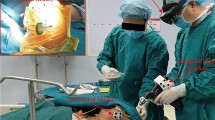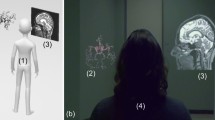Abstract
Hypertensive intracerebral hemorrhage (HICH) is a kind of intracerebral bleeding disease that affects 2.5 per 10,000 people world wide each year. An effective way of curing this disease is to perform a puncture procedure through the dura with a brain puncture drill and tube. The insertion accuracy determines the quality of surgery. Currently, augmented reality—and mixed reality (MR)-based surgical navigation is a promising new technology for surgical navigation in the clinic, aiming to improve the safety and accuracy of surgery. In this study, we present a novel multimodel MR navigation system for HICH surgery. With multi-information fusion technology, organs and hematoma data extracted from CT images can be fused with real patient, which allows surgeons to perform punctures easily. An automatic registration method with a 3D-printed fiducial marker was performed to significantly decrease the time required for surgery preparation.Phantom experiments and user tests were performed in this study, the results of these phantom experiments demonstrated that the mean registration error was 1.18 mm, the insertion error was 1.74 and the average time consumption was 15.9 min, which indicating that this approach was sufficient for clinical application. All the experimental results indicated that this system shows particular promise for use in training inexperienced surgeons, and the next steps would be to refine the system based on the findings with more experienced surgeons.










Similar content being viewed by others
Data availability statement
The datasets generated during and/or analysed during the current study are available from the corresponding author on reasonable request.
References
Andrea T, Kumar Rahul P, Ole E, Wiig O (2021) Mixed reality as a novel tool for diagnostic and surgical navigation in orthopaedics. Int J Comput Assist Radiol Surg 16(3):407–414
Asberg S, Farahmand B, Henriksson KM, Appelros P (2020) Statins as secondary preventives in patients with intracerebral hemorrhage. Int J Stoke 15(1):61–68
Benish F, Fabrizio C, Gregorio DF, Mauro F, Ferrari V (2018) Augmented reality in open surgery. Updat Surg 70(3):389–400
Besl PJ, Mckay HD (2002) A method for registration of 3-d shapes. IEEE Trans Pattern Anal Mach Intell 14(2):239–256
Bichlmeier C, Ockert SM, Ahmadi HA, Navab N (2008) Stepping into the operating theater: ARAV—augmented reality aided vertebroplasty. In: The 7th IEEE and ACM international symposium on mixed and augmented reality
Brand M, Wulff LA, Hamdani Y et al (2020) Accuracy of marker tracking on an optical see-through head mounted display. Ann Sci Soc Assemb Handling Ind Robot 2020:21–31
Colley A, Wolf D, Kammerer K et al (2020) Exploring the performance of graphically designed AR markers.In:19th International conference on mobile and ubiquitous multimedia. 2020:317–319
Daisuke S, Kieran J, Maki S, Horikita N, Hiyama A, Sato M, Devitt A, Watanabe M (2020) Augmented, virtual and mixed reality in spinal surgery: a real-world experience. J Orthopaedic Surg 28(3)
Dou H, Jiang S, Yang Z, Sun LQ, Ma XD, Huo B (2017) Design and validation of a ct-guided robotic system for lung cancer brachytherapy. Med Phys 44:4828–4837
Duliu A, Lasser T, Wendler T, Safi A, Ziegler S, Navab N (2010) Navigated tracking of skin lesion progression with optical spectroscopy. In: Proceedings of SPIE , vol 7624
Feng YY, Wang Q, Yang Y, Yan C (2019) Robust improvement solution to perspective-n-point problem. Int J Adv Robot Syst 16(6)
Frantz T, Jansen B, Duerinck J et al (2018) Augmenting microsoft’s HoloLens with vuforia tracking for neuronavigation. Healthcare Technol Lett 5(5):221–225
Hersch M, Billard A, Bergmann S (2012) Iterative estimation of rigid-body transformations application to robust object tracking and iterative closest point. J Math Imag vis 43(1):1–9
Itamiya T, Iwai T, Kaneko T (2018) The holographic human for surgical navigation using microsoft HoloLens. EPiC Ser Eng 1:26–30
Jing LM, Wang H, Wang LW (2012) 3D model reconstruction of the broken aeroengine blade Based on the detection operator. Adv Manuf Technol Syst 159:1
Kedilioglu O, Bocco T M, Landesberger M et al (2021) ArUcoE: enhanced ArUco marker. In: 21st International conference on control, automation and systems (ICCAS). 2021:878–881
Li K, Ding XQ, Wang QB et al (2021a) Low-cost, accurate, effective treatment of hypertensive cerebral hemorrhage with three-dimensional printing technology. Front Neurol 12:608403
Li Y, Cheng H, Li Z et al (2021b) Clinical value of 3D-printed navigation technology combined with neuroendoscopy for intracerebral hemorrhage. Transl Stroke Res 12:1035–1044
Lin CC, Tai YC, Lee JJ, Chen YS (2017) A novel point cloud registration using 2D image features. Eurasip J Adv Sig Pr 5
Muschelli J, Ullman NL, Sweeney EM, Eloyan A, Martin N, Vespa P, Hanley DF, Crainiceanu CM (2015) Quantitative intracerebral hemorrhage localization. Stroke 46(11):3270–3280
Pandey AS, Daou BJ, Chaudhary N, Xi GH (2020) A combination of Deferoxamine mesylate and minimally invasive surgery with hematoma lysis for evacuation of intracerebral hemorrhage. J Cerebral Blood Flow Metabol 40(2):456–458
Ramanan M, Shankar A (2013) Minimally invasive surgery for primary supratentorial intracerebral haemorrhage. J Clin Neurosci 20(12):1650–1658
Schlunk F, Chang YC, Ayres A, Battery T, Vashkevich A, Raffeld M, Rost N, Viswanathan A, Gurol ME, Schwab K, Greenberg SM, Rosand J, Goldstein JN (2016) Blood pressure burden and outcome in warfarin-related intracerebral hemorrhage. Int J Stroke 11(8):898–909
Traub J, Herrmann K, Lasser T, Navab N, Ziegler S, Buck A, Wendler T (2009) Freehand SPECT/ultrasound fusion for hybrid image-guided resection. Proc RSNA 36:S170–S170
Wang W, Zhou N, Wang C (2017) Minimally Invasive surgery for patients with hypertensive intracerebral hemorrhage with large hematoma volume: a retrospective study. World Neurosurg 105:348–358
Wang T, Zhao Q-J, Jian-Wen Gu et al (2019) Neurosurgery medical robot Remobot for the treatment of 17 patients with hypertensive intracerebral hemorrhage. Int J Med Robot Comput Assist Surg 15:e2024
Xiaojun Chen LuXu, Wang Y, Wang HX, Wang F, Zeng XS, Wang QG, Egger J (2015) Development of a surgical navigation system based on augmented reality using an optical see-through head-mounted display. J Biomed Inform 55:124–131
Zhang JF, Chen JS, Chen JB (2012) Influence of surgery with the guideline of minimally invasive concept in prognosis of patients with hypertensive basal ganglia hematomas: a report of 57 cases.Chin J Neuromed 11(4):401–404
Acknowledgements
This work was supported by the National Key R&D Program of China (No. 2022YFB4702600, 2022YFB4702601), the National Natural Science Foundation of China (No. 81871457, 8167071354) ,the Scientific and Technology Project of Jinnan District, Tianjin, China (No. 20200110) and the 2022 Excellent Doctoral Dissertation Fund of Tianjin University (No.1019201065).
Author information
Authors and Affiliations
Corresponding author
Ethics declarations
Conflict of interest
The authors declare that they have no conflict of interest.
Additional information
Publisher's Note
Springer Nature remains neutral with regard to jurisdictional claims in published maps and institutional affiliations.
Rights and permissions
Springer Nature or its licensor (e.g. a society or other partner) holds exclusive rights to this article under a publishing agreement with the author(s) or other rightsholder(s); author self-archiving of the accepted manuscript version of this article is solely governed by the terms of such publishing agreement and applicable law.
About this article
Cite this article
Zhou, Z., Yang, Z., Jiang, S. et al. Validation of a surgical navigation system for hypertensive intracerebral hemorrhage based on mixed reality using an automatic registration method. Virtual Reality 27, 2059–2071 (2023). https://doi.org/10.1007/s10055-023-00790-3
Received:
Accepted:
Published:
Issue Date:
DOI: https://doi.org/10.1007/s10055-023-00790-3




